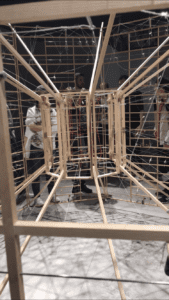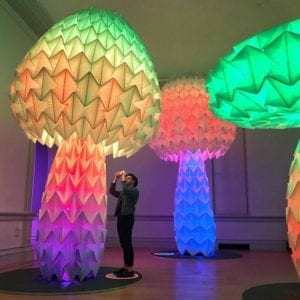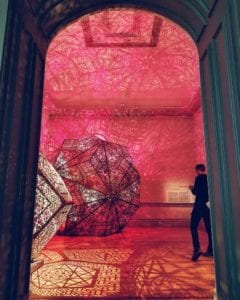In preparation for my Final IMA Project, I decided to look into existing interactive projects such as various art installations and interactive educational exhibitions. One of the exhibitions the school took us to was the Chronus exhibition located in the M50 Art District. We were shown six various technology-based art pieces that used electronics we had used in class, such as servo motors. The Rechnender Raum sculpture by Ralf Baecker is an art installation that uses servo motors, fiber strings, rubber bands and beechwood sticks to create an illusion of the inner workings of the computer. I noticed how the servo motors would move thereby causing the fiber strings to also move and change the position of the wooden set-up in the middle. Other exhibitions I have been to have both similar and different aspects with relation to the Chronus Exhibition.
I visited the Smithsonian Renwick Art Gallery while in Washington D.C. and one of the exhibitions I came across was titled “No Spectators: The Art of Burning Man”. This exhibition used technology, lights and various installations to portray a cultural festival that takes place in Nevada. However, unlike the Chronus exhibition, the mechanics or ‘behind the scenes’ components were not clearly visible (ie. in Chronus you can visibly see the DC Motors). I liked the Smithsonian’s exhibition because it focused on human connections in an age where digital media is so prevalent in our day to day lives, by allowing us to interact in a technological space while also preserving ancient culture and tradition. Similarly, the Chronus exhibition also tries to cast a light on man’s dependence on the computer and how this can have detrimental impacts. However, it did not allow for much interaction between the user and the installation and neither did the Renwick Gallery exhibition as they were both art installations and not interactive projects.



In order to further understand interaction with relation to technology I looked at other art installations and educational exhibitions. Researchers at UC Davis created an Augmented Reality Sandbox that projects a real-time and colorful “topographic map on a sandy surface”. The project allows individuals to create their own topographic map by moving the sand with their hands to create rivers, valleys and mountain ranges. This was a successful interactive project in my opinion as it allowed participants to interact with the sand and shape it into whatever they wanted. These shapes would then be translated into a topography through the use of augmented reality and could be placed in a museum to allow individuals to learn about geography and mapping. By creating a 3D visualization of earth and science concepts, the Augmented Reality Sandbox serves its purpose as an interactive and educational project.
Another project I came across was the Alive Art Gallery in Seoul, Korea that allows users to interact and talk to works of art. The project through various technology, was able to bring life to Da Vinci’s Mona Lisa allowing users to have a conversation with her. Although I found this somewhat interactive I did not really think it fit my definition of interaction as the audio voice-overs were pre-recorded and did not really engage the user in a proper conversation. I also personally found this to be a bit controversial as it was just putting random words in the mouths of age old paintings that have been revered all over the world, especially with specific religious paintings such as Da Vinci’s Last Supper.
All these projects made me rethink my definition of interaction. During the group project I had defined interaction with reference to the article “Art of Interactive Design”. The author likened interactivity to a conversation and so I had defined interaction as the ways in which humans communicate with electronic objects and how these objects react to our communication, creating a two way effect. In a conversation between two people, one participant has to listen, think and then speak or respond depending on what the other participant has just said and I saw this similarly in various technological projects I had come across. For instance in the Alive Art Gallery project, there was an actual conversation occuring between the user and the technology. However, by the time I had started doing research for my midterm project, my definition of interaction had altered. After delving deeper into Arduino and doing more readings on interactivity I saw it to be not only a form of communication but also a way of blending technology and human abilities together in the most natural way without undervaluing the capabilities of humans. This can be seen in the Augmented Reality Sandbox as it allows the users to use their hands and mould the sand to form a mountain, river etc. which would then translate into a topographic projection. This encouraged the use of one’s natural abilities and skills rather than making one fully dependant on technology to do all the work.
In researching for my Final project, I found my definition of interaction changing yet again. After reading “A Brief Rant on the Future of Interaction Design” by Bret Victor, I began to think about the ways in which technology of today is fully set on only fulfilling the needs of humans. Bret Victor on his blog encourages us to think outside the box and go one step ahead in terms of how technology can be revolutionary. He encourages us to not restrict interaction to the use of a single finger on a touch screen. I really agree with this as we had to consider this during our midterm project. Did we want to give the user the power to just push a button? Or were we going to think outside of the box and encourage the user to use his or her naturally given talents and capabilities? We settled on the latter option as we felt this would allow for interaction between man and technology without undermining man’s abilities. Similarly, this can be seen in the Augmented Reality Sandbox and even the Augmented Reality in Education Project which I had come across when researching for the Group Project.
Resources Used:
- A Brief Rant on the Future of Interaction Design by Bret Victor
- Responses: A Brief Rant on the Future of Interaction Design by Bret Victor
- http://www.chronusartcenter.org/en/cac-jwistmtcsisu/
- The Art of Interactive Design
- https://washington.org/visit-dc/burning-man-exhibit-renwick-gallery
- https://www.trendhunter.com/trends/the-seouls-alive-gallery-interactive-art-that-moves-and-talks
- https://www.trendhunter.com/trends/uc-davis-augmented-reality-sandbox
- https://www.hackster.io/G_Pehlivanides/augmented-reality-in-education-developing-discovery-based-learning-applications-9c4ea3